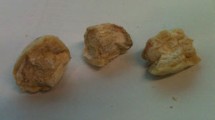Summary
Having demonstrated that the rat parotid gland is able to excrete a hypotonic saliva, we studied the formation of saliva in the different segments of the duct system, through micropuncture and microanalytical techniques. The duct system of the gland is composed of three functionally different segments, acini-intercalated ducts, striated ducts and excretory ducts. a) Acini-intercalated ducts secrete a primary fluid with plasma-like osmolality and sodium and potassium concentration. b) Striated ducts modify the primary fluid by active reabsorption of sodium in excess of water, thus producing hypotonicity. c) Excretory ducts serve as conduits of the saliva to the mouth. A process of reequilibration of the duct fluid to isotonicity occurs in the excretory ducts of the resting gland. Secretion of small amounts of potassium also appears to take place in these ducts.
Similar content being viewed by others
References
Brusllow, S. W., and R. W. Cooke: Role of parotid ducts in secretion of hypotonic saliva. Amer. J. Physiol. 196, 831 (1959).
Burgen, A. S. V., and N. G. Emmelin: Physiology of the salivary glands, p. 142, 152. London: Edward Arnold Publishers Ltd. 1961.
Cage, G. W., and R. H. Thompson: Potassium concentration of sweat as a function of sweat rate. Abstract. Nr. 1562 50th Annual Meeting of F.A.S.E.B Atlantic City, April, 1966.
Huff, E. G., N. S. Doss, and J. P. Wills: Effects of metabolic inhibitors and drugs on ion transport and Oxygen consumption in isolated frog skin. J. gen. Physiol. 41, 397 (1957).
Langley, L. L., and R. S. Brown: Relationship of salivary flow and pressure in dog submaxillary and parotid gland. Amer. J. Physiol. 201, 285 (1961).
Ludwig, G.: Neue Versuche über die Beihilfe der Nerven zur Speichelabsonderung. Z. rat. Med. 1, 277 (1851).
Lundberg, A.: Electrophysiology of salivary glands. Physiol. Rev. 38, 21 (1958).
Malnic, G., R. M. Klose, and G. Giebisch: Micropuncture study of renal potassium excretion in the rat. Amer. J. Physiol. 206, 674 (1964).
Mangos, J. A., and G. Braun: Excretion of total solute, sodium and potassium in the saliva of the rat parotid. Pflügers Arch. ges. Physiol. 290, 184 (1966).
-- -- Unpublished observations.
Martinez, J. R., H. Holzgreve, and A. Frick: Micropuncture study of submaxillary glands of adult rats. Pflügers Arch. ges. Physiol. 290, 124 (1966).
Ramsay, J. A., and R. H. J. Brown: Simplifield apparatus and procedure for freezing point determination upon small volumes of fluid. J. sci. Instrum. 32, 822 (1955).
Rutberg, U.: Ultrastructure and secretory mechanism of the parotid gland. Acta odont. scand. (Stockh.) 19, Suppl. 30 (1961).
Schögel, E., and J. A. Young: Micropuncture and perfusion investigation of sodium and potassium transport in the rat submaxillary gland. J. Physiol. (Lond.) 183, 73P (1966).
Schulz, I., K. J. Ullrich, E. Frömter, H. Holzgreve, A. Frick u. U. Hegel: Mikropunktion und elektrische Potentialmessung an Schweißdrüsen des Menschen. Pflügers Arch. ges. Physiol. 284, 360 (1965).
Strickler, J. C., and R. H. Kessler: Effects of certain inhibitors on renal excretion of salt and water. Amer. J. Physiol. 205, 117 (1963).
Thaysen, J. H.: Handling of alkali metals by exocrine glands other than the kidney. Handbuch der experimentellen Pharmakologie, Bd. 13, S. 427. Berlin, Göttingen, Heidelberg: Springer 1960.
— N. A. Thorn, and I. L. Schwartz: Excretion of sodium, potassium, chloride and carbon dioxide in human parotid saliva. Amer. J. Physiol. 178, 155 (1954).
Young, J. A., and E. Schögel: Investigation of the mechanism of sodium and potassium excretion in the rat parotid. Pflügers Arch. ges. Physiol. 291, 85 (1966).
Author information
Authors and Affiliations
Additional information
Supported by NIH Grant Nr. AM 06806-03 and by Deutsche Forschungsgemeinschaft.
From the Dept. of Pediatrics. University of Wisconsin, Madison Wisconsin, U.S.A. Supported by the National Cystic Fibrosis Foundation.
Rights and permissions
About this article
Cite this article
Mangos, J.A., Braun, G. & Hamann, K.F. Micropuncture study of sodium and potassium excretion in the rat parotid saliva. Pflügers Archiv 291, 99–106 (1966). https://doi.org/10.1007/BF00362655
Received:
Issue Date:
DOI: https://doi.org/10.1007/BF00362655




